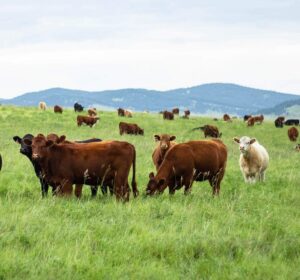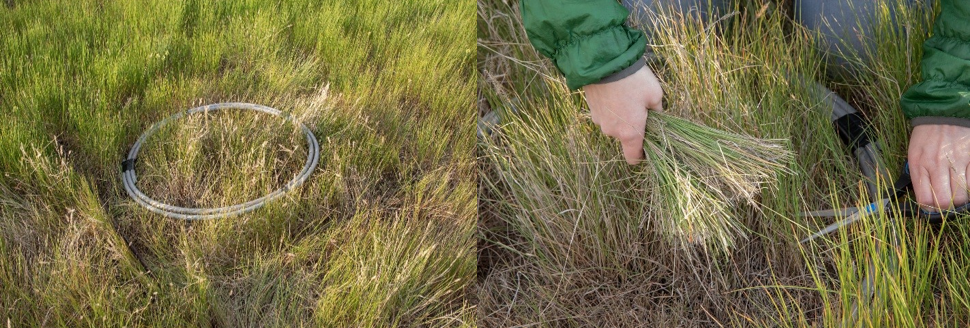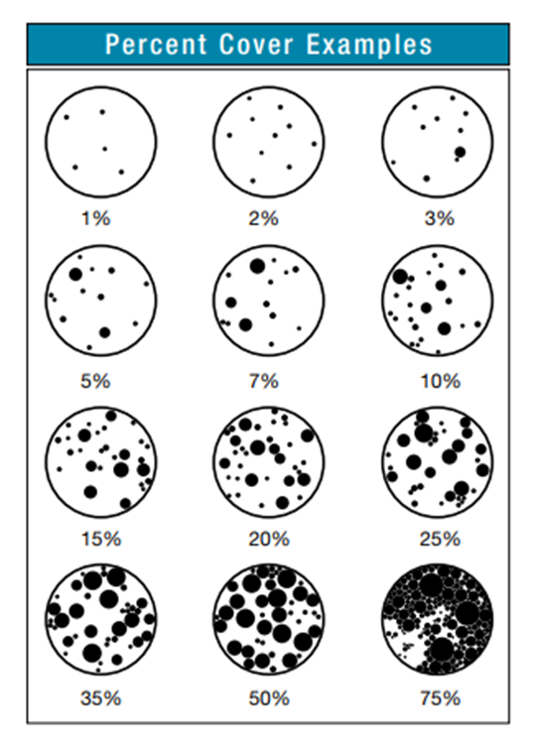Carrying or Grazing Capacity

Are you managing a new-to-you pasture and you need to determine how to stock it? Perhaps it has been recently purchased or rented, or you simply don’t trust the information provided on historical stocking rates.
The first principle of pasture management is to balance the available forage supply with livestock demand. Carrying capacity (also known as grazing capacity) is the amount of forage available for grazing animals in a specific pasture or field. A substantial amount of Canada’s rangeland is in some form of public ownership (e.g. grazing leases, forest grazing allotments) and has carrying capacity data available. With privately owned or recently acquired land however, there may not be any information on historical forage production and carrying capacity.
Carrying capacity can be calculated using a variety of techniques. All of them depend more or less on trial and error as they are monitored and adjusted over time as the carrying capacity for an individual year varies from the long-term average for the pasture. The effectiveness of each method depends on the kind of grazing land, but a combination of methods is generally required.
Carrying Capacity is defined as the average number of livestock and/or wildlife that may be sustained on a pasture that fits the management goals. Site characteristics, such as soil, water, plant, and topography of the pasture, can impact carrying capacity. Forage production and availability for grazing can also affect carrying capacity.
Source: Society for Range Management, 1998.
It should be noted that initial stocking rates will be based on preliminary information that should be replaced with recommended stocking rates as more data is accumulated on a specific pasture. Monitoring production and utilization throughout the grazing period will inform further adjustments in stocking rates throughout the grazing season.
The BCRC Carrying Capacity Calculator provides two methods: 1) estimates based on provincial guides and 2) field-based sampling.
Step 1: Map the range site (topography, soil types and zone) and vegetation types.
Step 2: Assess Range Health or Tame Pasture Condition (e.g. poor, fair, good or excellent).
Step 3: Use Provincial Forage Production Guides to get an initial stocking rate (animal units) for the pasture.
Step 4: Monitor condition and adjust stocking rate as needed.
Range Assessments and Pasture Condition
A Range Assessment uses a visual assessment of the pasture during the growing season. These are based on the person’s best visual estimate of the field and therefore are qualitative and subjective. Range or pasture condition assessments are most effective when consistently completed by the same person over time, under similar field conditions, and at the same time each year.
It is recommended to do at least three assessments per pasture; with more if the field varies in landscape or soil type in order to obtain the most accurate results. Large fields can be separated into sections based on soil types or topography. Avoid including areas near water, trees, or other areas where animal impact is concentrated. You may want to assess these areas separately if they are a substantial portion of the field. The scoring of indicators does not represent an absolute measure or value. Its purpose is to assess the ability of each pasture to function within its environment.
Native Range Assessment
Range health describes how the ecosystem is currently functioning compared with that of the potential for the site. This method evaluates five indicators including: plant community, structure, litter, site stability and weeds. Range condition compares the current plant community to its potential or “reference” plant community (known as the climax plant community). Four classes of range condition (Excellent, Good, Fair, Poor) explain how the composition of the present plant community has changed from that of the climax community.
Native Range is land supporting indigenous vegetation that either is grazed or that has the potential to be grazed and is managed as a natural ecosystem. Range includes grassland, grazable
Source: Society for Range Management, 1998.
For more information on evaluating range health visit the Rangeland and Riparian Health page or for available provincial information visit:
- British Columbia Grazing Management Guide
- Rangeland Health Field Guide (Section 5)
- Alberta Range Health Assessment , Range Health Tool Kit
- Saskatchewan Range Health Assessment Workbook (2008)
- Manitoba Range and Pasture Health Assessment Workbook (2017)
Tame Pasture Condition
The Tame Pasture Scorecard is a method to visually assess pasture health and productivity. It is a non-technical assessment ranking (low, medium, high) using the following indicators: plant population, plant density, plant vigour, legumes present, weeds and bush present, ground cover, soil damage, nutrient cycling, severity and uniformity of use. The Alberta Tame Pasture Scorecard is on page 39 of the West Central Forage Pasture Planner. This can be used to determine if tame pasture can be improved. Table 1 provides general descriptions used in classifying tame pastures (Excellent, Good, Fair or Poor).
Tame pasture is land that has been sown to cultivated grasses or legumes.
Table 1. Tame pasture class definitions

Source: Alberta Forage Manual (Table 37, page 206) adapted from Wroe et al. (1988) Guide to Range Condition and Stocking Rates for Alberta Grasslands
Method #1: Estimates based on provincial forage production guides
Forage productivity can be highly variable. Some provinces have developed range plant community guides that are linked to soil zones, ecoregions, or natural subregions. This approach seeks to establish a recommended grazing plan that averages out the peaks and valleys of production. Using estimates based on available provincial forage production guides is easy and convenient. This works best when the pasture condition (or range health) is similar throughout the field and the forage plant community (or range type) is uniform.
For native range, once range health is known, you can use the provincial guide to determine the number of animal unit months (AUMs) per acre for your soil zone. Provincial guides are available at:
- British Columbia Range Ecology
- Alberta Ecological site and community guides, Range Reference Areas
- Saskatchewan Rangeland Ecosystems: Ecosite Guide (2015)
- Manitoba Rangeland Classification
For tame pasture, once the pasture condition has been determined, if forage type is mixed, Table 2 provides estimated forage production and AUM per acre based on tame pasture condition and precipitation zone.
Table 2. Estimated forage production based on tame pasture condition

Source: Alberta Agriculture Beef Cow-Calf Manual or Alberta Forage Manual (page 205) adapted from Wroe et al. (1988) Guide to Range Condition and Stocking Rates for Alberta Grasslands
The forage production estimates can be put into the Method 1 – Use Provincial Production Guides version of the BCRC Carrying Capacity Calculator, along with the utilization rate and pasture size to get the total animal units. For example, if you have tame pasture in good condition with precipitation of 400mm that is 740 lb/ac (see Table 2). If the pasture is 160 acres with a utilization rate of 50% that is 76 animal unit months; equal to 58 cow-calf pairs for a month or 89 yearlings for a month.
There are other visual assessment methods for estimating forage production such as the falling plate meter (these must be calibrated for each region). Resources are available in provinces by contacting regional forage associations or extension specialists.
- Ontario Pasture Production – Publication 19
- Maritime Pasture Manual
Method #2: Field-based Sampling
Field-based sampling provides greater accuracy but also requires more hands-on work. This method can be beneficial if land has been purchased and you don’t know the grazing history or there are multiple forage types and pasture conditions throughout the field that don’t easily fit within any of the production guides. Producers can also use field-based sampling if provincial guides are unavailable for your region.
Since forage productivity can be highly variable from year to year, a forage sampling approach should include multiple years of sampling to estimate the long-term productivity of the pasture. Initial carrying capacity estimates can then be fine-tuned with less labour-intensive range health assessments.
Before starting, gather the supplies needed: a square frame that is 20 inches (50 cm) by 20 inches (50 cm) (i.e. 400 square inches) or circle frame (with a diameter of 22.5 inches or 56.4 cm), scissors to cut grass, paper bags, markers to identify location associated with each bag, a way to dry the samples and a scale (a kitchen scale works).
How many samples? The number of samples taken will vary with the size of the field and how uniform or varied the forage production is. The goal is to take enough samples to capture the variation in the pasture (e.g. low spots with high productivity and bald spots on hills) to be representative of production across the entire field.

Clipping. Clip samples of forage close to ground level within an area of 400 square inches (50cm x 50 cm) from representative areas of the pasture that have not been grazed. It’s best to clip in mid-July and mid-September building up data from a number of years to get a picture of the average forage yield that is representative across varying weather conditions. The picture shows a homemade circle using tubing and electrical tape.
Dry, Sort and weigh. Grass clippings can be dried in a food dehydrator, or at room temperature over several days (do not use the microwave!). Make sure to keep sample bags contained and identified. Weigh each bag for the total from each sample and enter into Method 2 of the BCRC Carrying Capacity Calculator, where there is a template where multiple samples from a pasture are averaged. A kitchen scale can be used to weigh the samples. Sorting the litter from the green material is optional, but if you choose to sort, tweezers make this tedious job easier. Enter the weight of the green material (litter weight is calculated and does not need to be weighed separately).
| To convert the forage yield from the 0.25 square meter sample to an acre the following formula is used: Dry forage grams x 35.6 = lbs/acre For example, if you had 50 grams of dried forage x 35.6 that equals 1,780 pounds of dry forage per acre. This is done for you in the BCRC Carrying Capacity Calculator. |

Note the percentage of litter cover. The amount of litter left on the land can make a big difference in the performance of the pasture. Litter includes ungrazed residue from the previous year’s growth, residue from bale grazing, fallen stems, leaf material and other partially decomposed material. Litter helps to conserve moisture by reducing evaporation, improving infiltration and cooling the soil surface and will impact utilization rates.
Once the forage supply is calculated, utilization rates and pasture size are used to determine the carrying capacity of the field.
Utilization Rates
The utilization rate determines how much forage is consumed or used through grazing, trampling, insects and wildlife. This helps determine how much material needs to be left remaining to maintain future production. Utilizing pasture at a rate that exceeds the plant communities’ ability to sustain itself can lead to increased weed invasion and reduced forage production and encourage less palatable and productive species to invade the pasture. Determining a suitable utilization rate can be a bit tricky, but general guidelines suggest the optimal utilization rate for native pasture can vary from 25-45% and in some areas up to 50%. Tame pastures can be utilized at 50-75% depending on fertilization. If the pasture is forested or covered in thick brush, the pasture size should be adjusted to reflect the acres of grazing available rather than the total acres in the field.
Factors affecting utilization on native range include:
- Ecological site – topography (e.g. steep slopes), type of soil (e.g. sandy or thin)
- Climate – soil zone impacts production even if same soil type
- Management – range health/pasture condition, adequacy of grazing distribution, season of grazing. For example, water location in the pasture will impact utilization and should be adjusted for.
Tame pasture also needs to consider:
- Type of forage (e.g. crested wheatgrass, alfalfa, timothy, or a mix of several species) and
- Age of stand
Carrying Capacity
Once the forage yield and utilization rate have been determined, the carrying capacity can be calculated from the total forage available. The amount of forage available is often expressed using a unit called an Animal Unit Month (AUM). An animal unit month is defined as the amount of forage a 1000 lb cow, with or without a calf, will consume in one month, and is equal to 780 lb (355 kg) of dry matter.
Table 4. Animal Unit Equivalents

Source: Animal Unit Months, Stocking Rate and Carrying Capacity
Animal Units are then used to develop grazing plans. Calculating the carrying capacity of a field is the first step to creating a grazing plan. The aim is to avoid overgrazing, under-grazing and support long term productivity under a variety of growing conditions. Grazing plans must also take into account variation in annual rainfall to avoid mismatches in forage supply and livestock demand from year to year.
Now that you have an initial estimate for your pasture’s carrying capacity, you can determine if it fits with existing management practices. Are any adjustments needed to account for your operation’s land, soils, or stand health goals? Does the pasture have the desired plant species composition? Understanding how to balance forage supply and demand, a key principle of pasture management, is the first step to addressing your pasture goals. There are a number of different approaches to grazing management that can be considered to help producers maintain long-term productivity of pastures.
Resources
- Grazing Management (BCRC webpage)
- Grazing Response Index (Agriculture and Agri-Food Canada)
- Management of Canadian Prairie Rangeland (Agriculture and Agri-Food Canada)
- Rangeland and Riparian Health (BCRC webpage)
Click here to subscribe to the BCRC Blog and receive email notifications when new content is posted.
The sharing or reprinting of BCRC Blog articles is welcome and encouraged. Please provide acknowledgement to the Beef Cattle Research Council, list the website address, www.BeefResearch.ca, and let us know you chose to share the article by emailing us at [email protected].
We welcome your questions, comments and suggestions. Contact us directly or generate public discussion by posting your thoughts below.